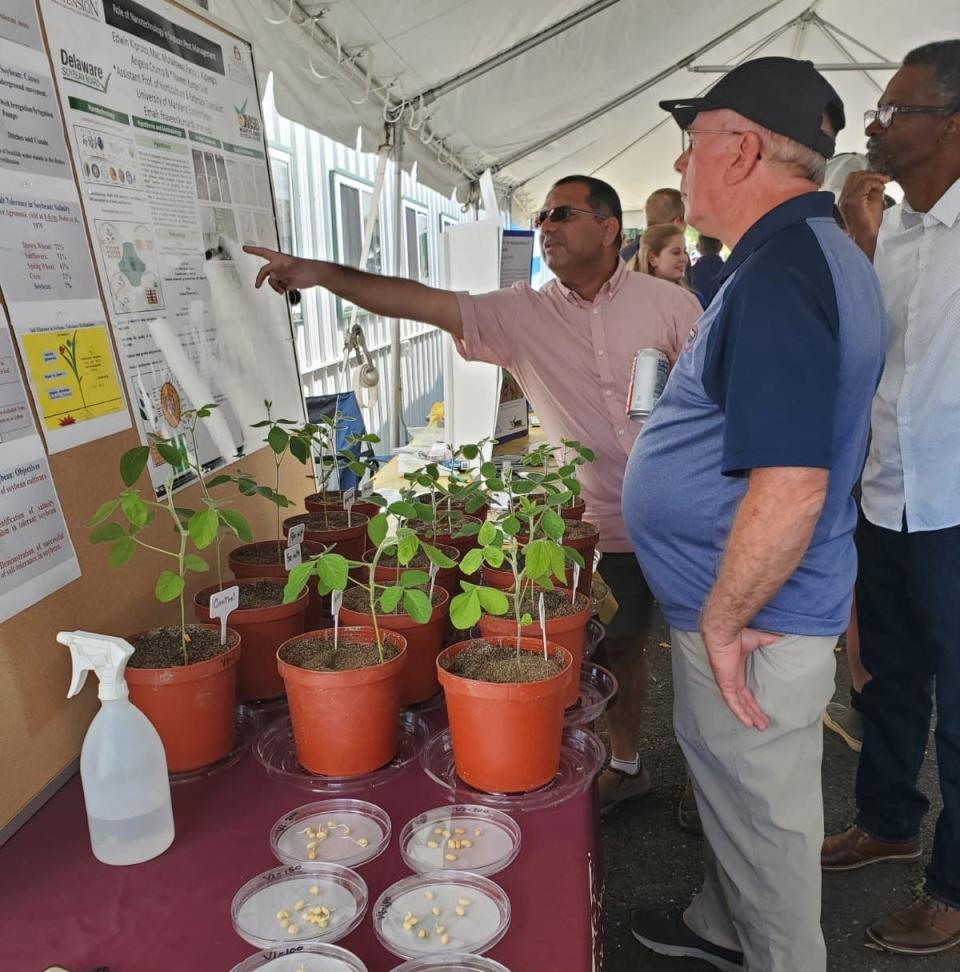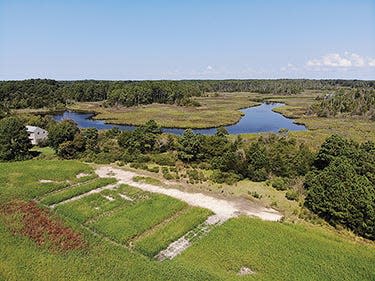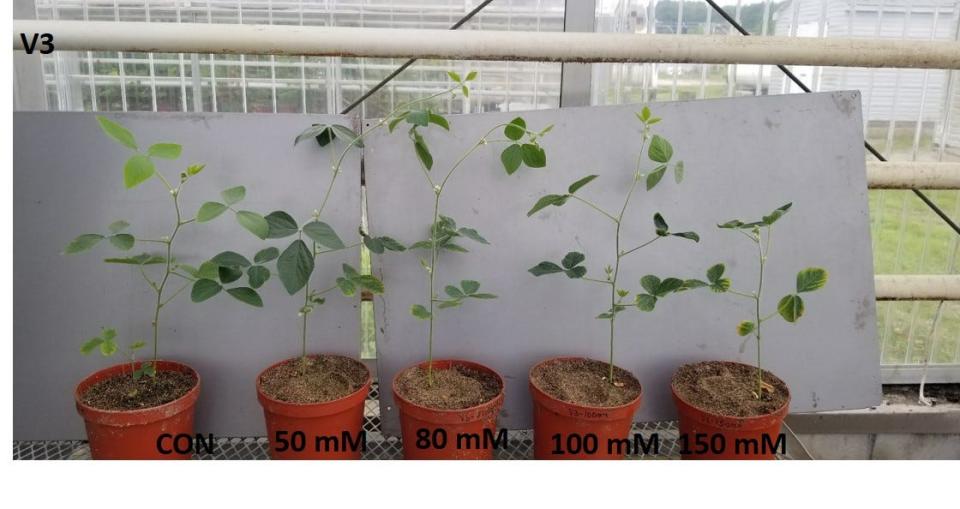Farmers battle climate change, sea level rise with new assist from UMES research
For farmers across the state, climate change impacts are more than political talking points and include uncharacteristic intervals of droughts and floods, plus the threat of sea level rise.
Groundbreaking research at the University of Maryland Eastern Shore is finally giving the agricultural community a new hope as it confirms many of the inconsistent weather patterns and even explores the reality of saltwater-resistant crops.
Naveen Kumar Dixit, Ph.D., associate professor of Horticulture and Extension Specialist at the university, is among those leading the way by offering Eastern Shore farmers a possible solution to a potentially multimillion-dollar problem in lost crops.
"In the last seven years, there's been a change in our rainfall pattern since when we need rain, we don't get it and when we don't need it, we get too much" Dixit said. "That could be a problem in winter, for example, in corn and soybean crops for harvesting. Excessive rainfall also impacts crops like strawberries that become watery and tasteless. Last year in July, (weather patterns) caused a decline in the yield of corn crop."

According to UMES data, troubling rain totals were just the beginning of farming woes for the Delmarva Peninsula. In Maryland, out of 23 total counties, 17 are exposed to a shoreline, making saltwater incursion from sea level rise a legitimate threat.
There is also a 3.4 millimeter a year sea level rise already being felt peninsula-wide, a measurement higher than the rest of the region. Counties like Dorchester, Worcester, and Somerset combine to have over 2,400 miles of shoreline alone.
While that annual sea level rise is roughly the size of a coriander seed, areas across the state are already seeing saltwater incursion in everything from the wetlands, neighborhoods, and crop fields meant to produce a livelihood.
"These plants have a special mechanism that actually prevents the uptick of sodium ions, so there is no incursion of these toxic elements in them. Secondly, some of these plants accumulate some compounds which counteract these toxic ions. In normal plants, where there is excessive salt outside, they won't take water," Dixit said.
More on other conservation efforts Maryland Gov. Wes Moore doubles down on Chesapeake Bay conservation efforts
Aside from soybeans, corn, strawberries and even hemp have shown to be resistant such ions.
The future of crop resiliency

While the research is still in its early stages, results have been promising, with the next five to 10 years looking like farmers getting science on their side.
According to Dixit, the slow start stems from the manipulation of the genes of the plants in question. That is easier said than done given the numerous pieces to the genetic puzzle that comprises these crops. In many cases, the question is deciphering which gene controls the creation of the toxic ion-fighting feature.
"It will take time because of the scientific constraints in the research. When we manipulate one or two genes, these resistant qualities are controlled by multiple genes. We are conducting this research in our controlled conditions, but we'll see when they're outside and facing multiple stressors," Dixit said.
For Dixit and the team of researchers looking to grow the next generation of successful crops, this is just one aspect of dealing with climate change. The future of farming, Dixit noted, is teaching those in and out of the industry to control and minimize greenhouse gases.

While the merits of climate change assertions continue to become politicized, farmers are already taking innovative approaches to land management. In the Northeast, that now includes earthworks and artificial ponds to trap or catch excess water in times of inconsistent rain.
Adapting to climate change on the farm
Morgan Gold, owner and operator of Gold Shaw Farm in Vermont, knows all too well the challenges the northeast of the country is facing when it comes to agriculture. As an outspoken activist on the impacts of climate change on farming, he has shared his story of trying to raise a variety of animals and plants on his property.
"Ever since we started our operation in 2018, I've been struck with the volatility in climate, whether that's average rainfall years followed by drought or near drought conditions," Gold said. "This past July, we've been inundated with massive flooding. So it's been challenging trying to raise ducks, geese, cattle, trees and managing all that. You also have to think about how to manage pastures when they become inundated or in droughts."
For grazing cattle, the sight of grass not growing fast enough in drought conditions is an unwelcomed surprise. Then again, so is a field muddy from a torrent of rainfall.
More on Bay health Chesapeake Bay watershed may be resilient over time. But 'healthy' is far off, study says
For Gold, staying attentive to the signs of oncoming drought and using miles of swales and berms is just the start. The sweat equity he has put into his property has also come with a tangible financial boost in infrastructure improvements.
Recent floods have caused significant damage to farm infrastructure, including buildings, machinery and soil health, leading to additional financial burdens. The combination of reduced crop yield from droughts and infrastructure damage from floods, coupled with the cost of adapting to new conditions, has placed a significant financial strain on the operation of the farm.
While he has been relatively insulated from severe costly losses this year, the same cannot be said for many of his fellow farmers in Vermont. Many have already seen over $100,000 in unrecoverable revenue due to climate change-related weather patterns.
Gold, is also keenly aware of the other footprints farming leaves and is already working smarter rather than harder.
"In terms of controlling runoff issues, not having many concentrated manure operations is a big part of it. Our cattle are rotationally grazed daily and sometimes twice a day. That is even distribution of manure across the pasture. That keeps us from concentrated manure situations or manure lagoons which contribute runoff," Gold said.
More on alternative energy Wes Moore intensifies Maryland offshore wind energy push, drawing Andy Harris rebuke
This article originally appeared on Salisbury Daily Times: UMES gives farmers new weapon to battle climate change, sea level rise

